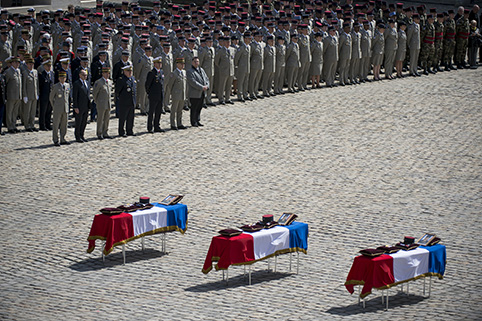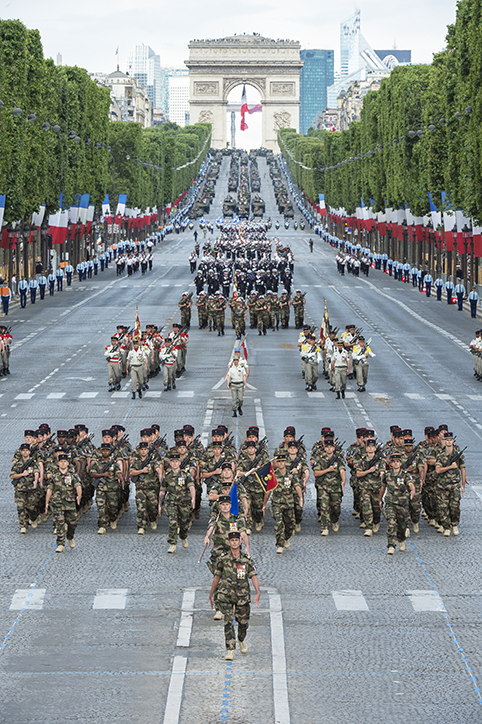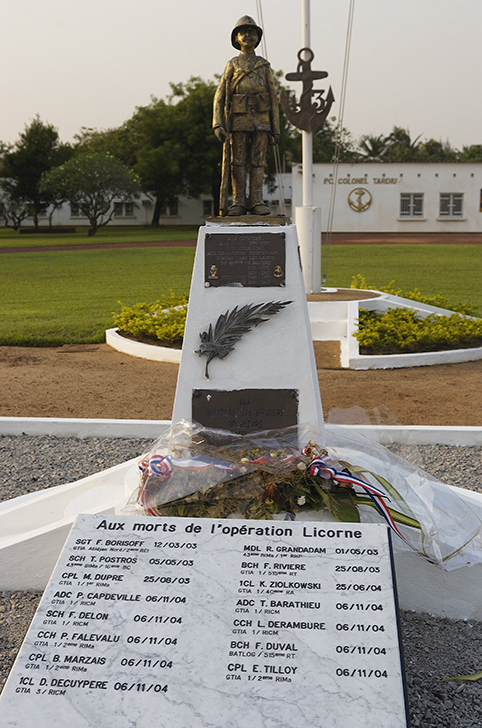Towards the remembrance of overseas operations

In recent years, there has been a step change in public awareness of the sacrifices made by servicemen and women deployed on overseas operations, especially with State memorial services for personnel killed on operations. But these dramatic events are not new. The time separating us from the first overseas operations offers researchers today the distance they need to interrogate this recent memory still under construction.
All wars elicit remembrance. It often crystallises around those killed in action, and is borne by those that survive. While this remembrance has its roots in the 19th century, it was with the First World War that remembering the dead, and by association the war itself, became firmly established. Practices and usages went on to serve as models for subsequent conflicts (the Second World War, the wars of decolonisation). Yet with overseas operations, the construction of remembrance and the honouring of the dead became more difficult tasks to accomplish. From 1962 to the present, France has sent its armed forces to different parts of the globe for a wide variety of reasons. It was present in the former Yugoslavia from 1992 to 1995, as part of the UN peacekeeping mission. French troops also come to the aid of French and European nationals, as in 1978 in Kolwezi, in the present-day Democratic Republic of the Congo. France engages alone or as part of international coalitions, as in the Gulf War in 1990-91. Finally, it carries out protection and surveillance missions, for instance combating piracy in the Indian Ocean. Over the course of these different operations, France has lost more than 600 service personnel. In the past, following the two world wars and the wars of decolonisation, the local communes and veterans soon put in place a system for ensuring a lasting tribute to their dead, with a precise institutional calendar and a shared place of remembrance in the form of war memorials. But with overseas operations, that did not happen, and initiatives were a long time coming.

© S. Dupont/ECPAD/Défense
Towards the construction of remembrance of overseas operations
The professional status of armed forces personnel and their engagement in distant foreign theatres tend to be obstacles to the development of specific remembrance. Yet professional soldiers in the two world wars are honoured in the same way as conscripts and volunteers on war memorials. Career soldiers killed in Salonika in 1916 or in Narvik in 1940 both receive that honour. The determining factor, then, appears to be the geopolitical context; the death must be linked to a war of global proportions involving France. The absence of associations of veterans of overseas operations in the communes also makes it difficult to create a specific tribute at local level. Finally, compared to previous wars, very few communes have had to come to terms with losing one of their own on an overseas operation. As a result, society’s knowledge and recognition of them was a long time coming, and it was not until the 2000s, with the media impact of the war in Afghanistan and operations Serval and Barkhane, that the general public became genuinely aware of overseas operations. The context of a war on terror and the almost instant announcement by continuous news networks of the deaths of French service personnel revealed the importance of these actions carried out by France. Since then, although not new, a genuine remembrance of overseas operations has developed, structured around honouring service personnel killed in combat.
As for earlier conflicts, there are different levels of remembrance and commemoration. The first to be affected by a death are those engaged on the front line. They must organise the recovery and repatriation of the body, and above all cope with the loss of a comrade, while at the same time continuing to fight. In his Journal de marche d’un chef de corps français en Afghanistan (Diary of a French commander in Afghanistan), Colonel Nicolas Le Nen tells of this initial stage of dealing with death in combat. Confronted with the death of Corporal Nicolas Belda, of the 27th Battalion of Chasseurs Alpins (BCA) of Annecy, on 13 March 2009, Le Nen advocates the idea of not abandoning the soldier, at the same time as he affirms the need to carry on with the operation. Mourning is therefore postponed for the duration of the fighting.
Deaths on overseas operations: military remembrance
This first stage nevertheless plays an important part in the development of military remembrance. That remembrance in turn comprises two stages. An initial ceremony centres on the dead serviceman’s coffin, which is covered with the tricolour flag. It often takes place at the barracks of the regiment concerned, as for the memorial service for Loïc Roperh, killed in action in Afghanistan on 10 May 2011, which was held in Valdahon, where his regiment, the 13th Engineers, is based. In other instances, the ceremony has taken place in the parade ground at Les Invalides, as on 20 April 2016 for the three servicemen of the 511th Transport Regiment of Auxonne, killed near Tessalit, in Mali, on 12 April 2016. These memorial services contribute to the construction of remembrance of overseas operations because of their official character, but also by diffusing powerful images and symbols to French society. The presence of the most senior representatives of the French State at these ceremonies, not least the President of the Republic, further accentuates this aspect. Once the body has been returned to the family, a second stage cements the tribute and gives material expression to regimental remembrance, through a monument. In the Place du Col du Midi, at the barracks of the 93rd Mountain Artillery Regiment (RAM), in the neighbourhood of Reynies, Varces, stands a memorial to the members of the regiment killed in Afghanistan. This same monument honours the members of the 93rd RAM killed in the wars of decolonisation. This practice ensures the visibility and longevity of a remembrance specific to the military unit concerned, at its own barracks. One of the symbols on the monument, the emblem of the 93rd RAM, both identifies the dead soldiers as belonging to the regiment and the regiment as being the source of the tribute. Ceremonies are held periodically to remember the dead. By placing the memorial within the barracks, the intention is also to present a model of devotion and abnegation to be imitated by members of the regiment. In recent years, this memory under construction has also found expression on the internet: websites and blogs concerned specifically with overseas operations or a particular regiment provide a space for more personal tributes celebrating the memory of those killed in combat. A wide variety of videos, photomontages and texts are a way of paying tribute while at the same time reinforcing the sense of group cohesion. The use of regimental symbols, combined with photographs of the deceased or reminders of their life, are as much an attempt to justify their death as to ensure the continuity of their memory.
Deaths on overseas operations: family remembrance
The second group to be affected by a death on an overseas operation is the family. Unlike in the two world wars, nowadays the families of service personnel killed on operations are notified much more quickly. This short timescale reduces the feelings of guilt experienced by family members who have carried on obliviously with their lives between the death and the notification. A form of tribute is quickly assembled in the context of family remembrance. It is the family that decides on the place of burial and part of the ceremony. Despite being the private sphere, these expressions still have an influence on the wider remembrance of overseas operations because they take place in the public domain. In recent years, some families have published their own personal accounts on the internet, offering a more precise picture of the deceased serviceman or woman. A wide variety of tributes of this kind can be found online. They are the work of family members, friends or others with something to say, a tribute or a demand to make in connection with the loss of a loved one on an overseas operation. This contributes to spreading a particular image of these operations, or simply making them known. This virtual remembrance is mainly focused on more recent conflicts, like Afghanistan and Mali. The timescale for remembrance is more personal and specific to each family. It might be organised around the deceased’s birthday or other anniversary, or in the context of a national day of remembrance. This private sphere is crucial to understanding the repercussions of overseas operations. It gives a personal face to death in combat in the form of moving tributes, crucial to the construction of lasting remembrance.

© J. Salles/ECPAD/Défense
Bastille Day: positive remembrance of overseas operations
Finally, overseas operations are remembered on a broader level. On 14 July, Bastille Day, the French nation celebrates its armed forces. Military parades, the biggest of which takes place on the Champs-Élysées under the aegis of the French President, play a unifying role. Units of the different armed forces, and hence the servicemen and women that constitute them, are the focus of everyone’s attention, admiration, respect and applause. These ceremonies are at once a military parade and a form of deep recognition. As well as offering a clearer idea of the relationship between society and its armed forces, they are also part of the construction of remembrance of overseas operations, in the sense that the theatres of intervention are remembered and often referred to specifically. This enables French people to have a better understanding of their armed forces’ involvement around the world. Bastille Day makes remembrance about more than just honouring the dead, which is particularly significant as the dead do not always receive that honour in the first instance.

© ECPAD/Défense
Developing remembrance in the communes
Up until the beginning of the 21st century, service personnel killed in foreign theatres of operations were often forgotten. At commune level, the practice in place was highly random. Because a municipality’s tribute starts with the local war memorial, that tribute was not paid to any serviceman or woman killed on overseas operations whose name was not inscribed on the memorial. In some cases, their name might not be included because they were not recognised as having “died for France” in the operation. The website “Mémoire des Hommes” identifies the case of Captain Rémy Basset, of the 6th Marine Infantry Parachute Regiment, who died in Chad on 6 March 1993. His name does not appear to be inscribed on any war memorial, either in Tullins (Isère), the commune of his birth, or in Mérignac (Charente), where he is buried. The reason for this absence is that Basset was not recognised by the National Office for Veterans and Victims of War, in Caen, as having “died for France” until 23 April 2014. So the declaration was not issued as a matter of course for overseas operations, or might be attributed subsequently. That is the reason why the communes took no action to add a name to their war memorials. As a result, for decades overseas operations remained in the shadows of remembrance. They had neither a physical monument in their honour, nor a commemorative calendar to affirm their reality, in a society that had little interest in these distant conflicts. After all, how many French people today can still recall the locations, dates and reasons for the different overseas operations?
The construction of specific remembrance for these operations seemed highly unlikely then, without a significant change in society. That change came about in the early 2010s, with initiatives in communes such as Saint-Aupre, in Isère. The inscription of the name of Clément Chamarier on the village war memorial, with the words “died in Afghanistan”, was unveiled on 11 November 2011. On the decision of the mayor and local council, in agreement with the local veterans’ association, this member of the 7th Battalion of Chasseurs Alpins (BCA) of Bourg-Saint-Maurice, killed in Kapisa Province on 19 February 2011, was honoured alongside those from the commune who lost their lives in the two world wars and the wars of decolonisation. The unveiling ceremony, in the presence of the communal authorities, a detachment of the 7th BCA, General Wattecamps, then commander of the 27th Mountain Infantry Brigade, and a fairly large crowd, signified the admission of overseas operations into the communal pantheon. Media coverage of the event also helped change the image of overseas operations, as well as their place in the collective memory. It was not long before the State followed suit.
Towards State involvement
Although not as significant as in previous wars, the number of deaths in Afghanistan, coupled with the publicity given to deaths in contemporary conflicts, forced the French State to act. A first step to re-evaluate the importance of overseas operations came with the law of 28 February 2012. This new law required the communes to inscribe on or near their war memorials the names of those whose death certificates bore the words “died for France”. From then on, all service personnel who lost their lives on overseas operations and obtained that declaration had their names inscribed on their commune’s war memorial. For the first time ever, the decision was not in the hands of the communes, or even the families, who could not refuse the honour, since the inscription was now compulsory. The same law made 11 November the day of remembrance of all those who died for France, whatever the conflict. 11 November became a kind of catalyst for the remembrance of all those killed in combat, enabling overseas operations to become fully incorporated into the collective memory. Even so, the speeches made before war memorials on that day continued to focus primarily on the First World War.
A second initiative from the State is centred on the creation of a national memorial to those killed in overseas operations. The initiative brings together all those killed in Chad, Lebanon, the former Yugoslavia, Afghanistan, Mali and all the other countries where France has deployed its troops in the national and international interest. The monument is another step in affirming the memory of overseas operations, which has been under continual construction for more than 50 years. It will also be the nation’s tribute to its armed forces.
The remembrance of overseas operations is now fixed in time, with communes across France marking it on 11 November every year. It will soon also be fixed in space, with the inauguration of this national memorial. While there may still be some debate and disagreement over the legitimacy of overseas operations, economic issues or the location of the monument, they appear to be in the minority, at a time when the war on terror and the quest for global stability are priorities for the French State and the vast majority of French people. Nevertheless, it will be fascinating to follow the evolution of this remembrance over the decades to come, in order to ascertain where it stands in relation to remembrance of the two world wars and the wars of decolonisation. It would be interesting to know whether this remembrance can really succeed in encompassing all overseas operations, or whether a lower priority will be given to some as compared to others.
Author: Jérémy Pignard, PhD in History, Associate Researcher at LARHRA, History and Geography Teacher at Grenoble Education Authority

